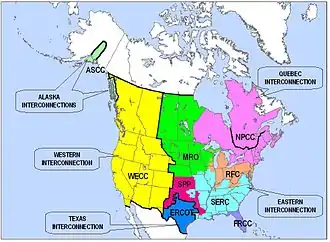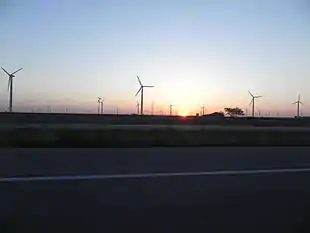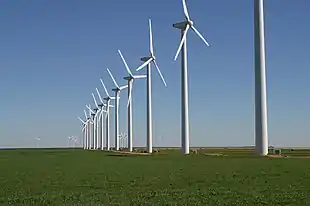Texas Interconnection
The Texas Interconnection is an alternating current (AC) power grid – a wide area synchronous grid – that covers most of the state of Texas. The grid is managed by the Electric Reliability Council of Texas (ERCOT).

The Texas Interconnection is one of the three minor grids in the continental U.S. power transmission grid. The other two minor interconnections are the Quebec Interconnection and the Alaska Interconnection. The two major interconnections are the Eastern Interconnection and the Western Interconnection. The Texas Interconnection is maintained as a separate grid for political, rather than technical reasons.[1] In most respects, it is not subject to Federal Energy Regulatory Commission regulation.
All of the electric utilities in the Texas Interconnection are electrically tied together during normal system conditions and operate at a synchronized frequency operating at an average of 60 Hz.
Interconnections can be tied to each other via high-voltage direct current power transmission lines (DC ties), or with variable-frequency transformers (VFTs), which permit a controlled flow of energy while also functionally isolating the independent AC frequencies of each side. The Texas Interconnection is tied to the Eastern Interconnection with two DC ties, and has a DC tie and a VFT to non-NERC systems in Mexico. There is one AC tie switch in Dayton, Texas that has been used only one time in its history (after Hurricane Ike).
On October 13, 2009, the Tres Amigas SuperStation was announced to connect the Eastern, Western and Texas Interconnections via three 5 GW superconductor links.[2] As of 2017, the project was reduced in scope and only related infrastructure was constructed for nearby wind projects connecting to the Western Interconnection.
Power demand is highest in summer, primarily due to air conditioning use in homes and businesses. On July 19, 2018 consumer demand hit 73,259 MW.[3] A new peak of 74,820 MW was set between 4 p.m. and 5 p.m. Central Daylight Time (2200 GMT) on Monday, August 12, 2019 as high temperatures in Houston hit 100 degrees Fahrenheit (38° Celsius).[4] ERCOT had more than 78,000 MW of generating capacity available to meet demand in the summer of 2019, providing an adequate though not generous margin. For 2020, the forecasted peak demand is 76,696 MW.[5] A megawatt of electricity can power about 200 Texas homes during periods of peak demand.
In an early morning period of low electricity demand, wind energy served more than 56% of total demand at 3:10 am Central Standard Time on Saturday, January 19, 2019.[6] Two days later, ERCOT set a new wind output record of nearly 19.7 GW at 7:19 pm Central Standard Time on Monday, January 21, 2019.[7]
Electric Reliability Council of Texas
The Electric Reliability Council of Texas (ERCOT) manages the flow of electric power on the Texas Interconnection that supplies power to 24 million Texas customers – representing 85 percent of the state's electric load.[8] ERCOT is the first independent system operator (ISO) in the United States[9] and one of nine ISOs in North America.[10] ERCOT works with the Texas Reliability Entity (TRE),[11] one of eight regional entities within the North American Electric Reliability Corporation (NERC) that coordinate to improve reliability of the bulk power grid.[12]
As the ISO for the region, ERCOT dispatches power on an electric grid that connects 46,500 miles of transmission lines and more than 550 generation units.[13] ERCOT also performs financial settlements for the competitive wholesale bulk-power market and administers retail switching for 7 million premises in competitive choice areas.[14]
ERCOT is a membership-based 501(c)(4) nonprofit corporation, governed by a board of directors and subject to oversight by the Public Utility Commission of Texas (PUC) and the Texas Legislature.[15][16]
ERCOT's members include consumers, electric cooperatives, generators, power marketers, retail electric providers, investor-owned electric utilities (transmission and distribution providers), and municipally owned electric utilities.[17]
Production
| Mode | 2019 (GWh) |
|---|---|
| Biomass | 421 |
| Coal | 77,857 |
| Gas | 27,379 |
| Gas-CC | 154,391 |
| Hydro | 956 |
| Nuclear | 41,314 |
| Other | 24 |
| Solar | 4,398 |
| Wind | 76,708 |
| Total | 383,447 |
| Refs | [18] |
Wind power in Texas

Wind power in Texas consists of over 40 wind farms, which together have a total nameplate capacity of over 28,000 MW (as of 2019).[19][20] If Texas were a country, it would rank fifth in the world:[19] The installed wind capacity in Texas exceeds installed wind capacity in all countries but China, the United States, Germany and India. Texas produces the most wind power of any U.S. state.[19][21] According to ERCOT (Energy Reliability Council of Texas), wind power accounted for at least 15.7% of the electricity generated in Texas during 2017, as wind was 17.4% of electricity generated in ERCOT, which manages 90% of Texas's power.[22][23] ERCOT set a new wind output record of nearly 19.7 GW at 7:19 pm Central Standard Time on Monday, January 21, 2019.[24]
The wind resource in many parts of Texas is very large. Farmers may lease their land to wind developers, creating a new revenue stream for the farm. The wind power industry has also created over 24,000 jobs for local communities and for the state. Texas is seen as a profit-driven leader of renewable energy commercialization in the United States. The wind boom in Texas was assisted by expansion of the state’s Renewable Portfolio Standard, use of designated Competitive Renewable Energy Zones, expedited transmission construction, and the necessary Public Utility Commission rule-making.[25]
The Roscoe Wind Farm (781 MW), near the town of Roscoe, is the state's largest wind farm. Other large wind farms in Texas include: Horse Hollow Wind Energy Center, Sherbino Wind Farm, Capricorn Ridge Wind Farm, Sweetwater Wind Farm, Buffalo Gap Wind Farm, King Mountain Wind Farm, Desert Sky Wind Farm, Wildorado Wind Ranch, and the Brazos Wind Farm.
Solar power in Texas

Solar power in Texas,along with wind power, has the potential to allow Texas to remain an energy-exporting state over the long term. The western portion of the state especially has abundant open land areas, with some of the greatest solar and wind potential in the country.[27][28] Development activities there are also encouraged by relatively simple permitting and significant available transmission capacity.[29][30]
References
- http://www.slate.com/articles/news_and_politics/explainer/2003/08/why_texas_has_its_own_power_grid.html
- High-Temp Superconductors To Connect Power Grids
- "Texas is using a record amount of electricity. Could demand outpace supply?".
- "Texas power demand sets record high as heat wave bakes U.S. Southeast". Reuters. 2019-08-12. Retrieved 2019-08-18.
- "News Release: ERCOT's reserve margin climbs 2% for summer 2020". ERCOT.com. ERCOT. 5 December 2019. Retrieved 28 July 2020.
- "ERCOT Sets Record Wind Output and Penetration Rate Over the Holiday Weekend". TREIA-Texas Renewable Energy Industries Alliance. Retrieved 2019-08-18.
- "ERCOT Sets Record Wind Output and Penetration Rate Over the Holiday Weekend". TREIA-Texas Renewable Energy Industries Alliance. Retrieved 2019-08-18.
- ERCOT History, http://www.ercot.com/about/profile/history/
- ISO/RTO Council homepage, "Archived copy". Archived from the original on 2012-12-27. Retrieved 2013-04-22.CS1 maint: archived copy as title (link)
- Texas Reliability Entity homepage,"Archived copy". Archived from the original on 2013-03-28. Retrieved 2013-04-22.CS1 maint: archived copy as title (link)
- NERC, http://www.nerc.com/page.php?cid=1%7C9%7C119
- ERCOT Quick Facts, October 2017, http://www.ercot.com/content/wcm/lists/114739/ERCOT_Quick_Facts_101317.pdf
- ERCOT Quick Facts, http://www.ercot.com/content/wcm/lists/114739/ERCOT_Quick_Facts_101317.pdf
- ERCOT Governance, http://www.ercot.com/about/governance/
- About ERCOT, http://www.ercot.com/about/
- ERCOT membership, http://www.ercot.com/about/governance/members/
- http://www.ercot.com/content/wcm/lists/181766/FuelMixReport_PreviousYears.zip
- AWEA Texas Fact Sheet (Q2 2019)
- "Utility wind rush set to strengthen as low prices allow resource to spread across nation". Utility Dive. Retrieved 2019-10-19.
- "AWEA Third Quarter 2012 Market Report" (PDF). awea.org. Retrieved 11 April 2018.
- "ERCOT Quick Facts for 2017 published July 2018" (PDF). ercot.com. 2018-07-01. Retrieved 2018-09-09.
- "ERCOT Quick Facts for 2017 published February 2018" (PDF). dropbox.com. 2018-02-01. Retrieved 2018-02-08.
- "ERCOT Sets Record Wind Output and Penetration Rate Over the Holiday Weekend". TREIA-Texas Renewable Energy Industries Alliance. Retrieved 2019-08-18.
- Lauren Glickman (25 August 2011). "Stetsons Off to Gov. Perry on Wind Power". Renewable Energy World.
- Output data
- "A State-By-State View Of U.S. Renewable Energy In 2017". solarindustrymag.com. Retrieved 7 February 2019.
- "Comparison of Solar Power Potential by State". neo.ne.gov. Retrieved 7 February 2019.
- "Is a Solar Development Boom About to Begin in Texas?". greentechmedia.com. Retrieved 7 February 2019.
- Accounts, Texas Comptroller of Public. "State Energy Conservation Office". www.seco.cpa.state.tx.us. Retrieved 23 April 2018.
